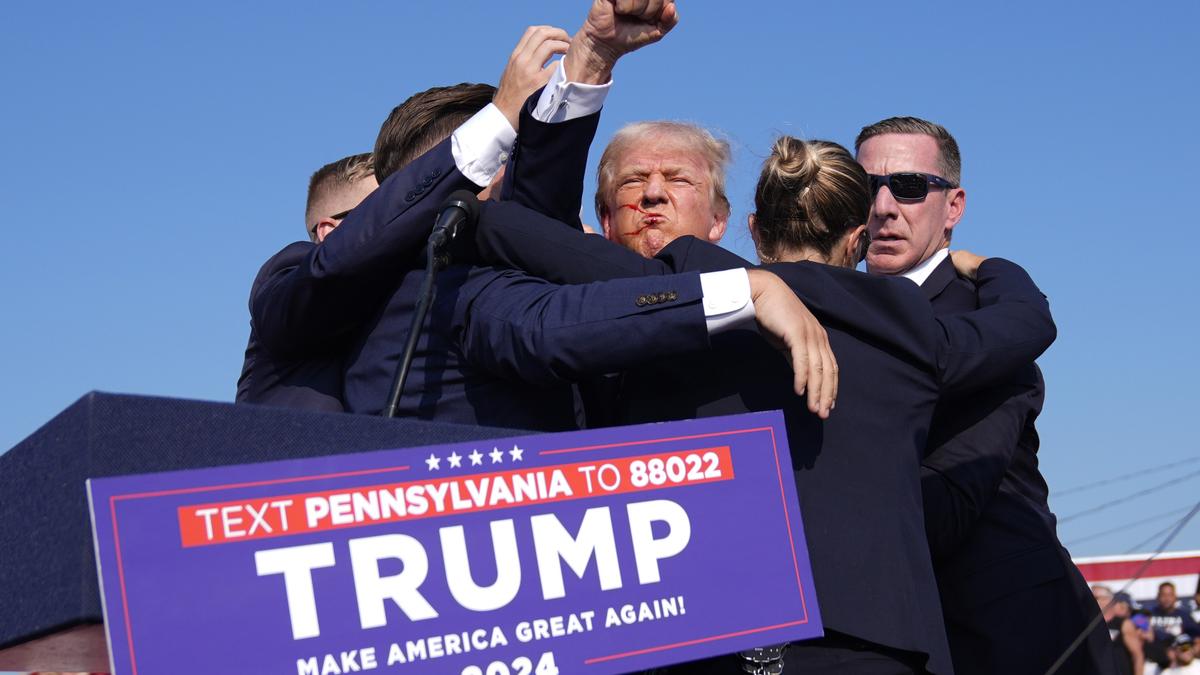Republican presidential candidate former President Donald Trump gestures as he is surrounded by U.S. Secret Service agents at a campaign rally, on July 13, 2024, in Butler, Pa.
| Photo Credit: AP
Shots were fired during a rally speech by Donald Trump, in an incident that investigators are treating as a possible assassination attempt on the former President.
Including Abraham Lincoln and JFK, here are some notable examples of shootings involving U.S. Presidents or presidential candidates:
Donald Trump shooting LIVE updates July 14, 2024
Ronald Reagan (1981)
President Ronald Reagan waves and then looks up before being shoved into the President’s limousine by secret service agents after being shot outside a Washington hotel, March 30, 1981. The assassination attempt of former President Donald Trump has parallels to the last time a president or presidential candidate was wounded — in 1981 when Ronald Reagan was nearly killed by an assailant’s bullet. Reagan’s life was spared thanks to the quick actions of a Secret Service agent and the skill of doctors and nurses at a Washington, D.C., hospital.
| Photo Credit:
AP
President Reagan was shot and seriously wounded as he left an event at the Hilton hotel in Washington. The attacker was John Hinckley Jr, who was granted unconditional release in 2022.
Reagan spent twelve days in the hospital. The incident boosted Reagan’s popularity, as he displayed humor and resilience during his recovery.
Gerald Ford (1975)
United States President, Gerald R. Ford, is clutched in the hands of Secret Service people shortly after an attempt was made on his life in California’s Capitol of Sacramento on September 5, 1975.
| Photo Credit:
AP
President Ford was left unscathed in two separate assassination attempts by women in September 1975, both in California and within a span of just 17 days.
George Wallace (1972)
People mill around a shopping center parking lot in Laurel, Md., after an assassination attempt on Alabama Gov. George Wallace, who was campaigning for president, on May 15, 1972. Wallace was paralyzed by shots fired by Arthur Bremer.
| Photo Credit:
AP
While campaigning for the Democratic presidential nomination, Wallace was shot four times and paralyzed for life at a shopping mall in Laurel, Maryland.
Alabama’s Governor George Wallace seated in wheel chair is pushed through the hallway of Holy Cross Hospital by his wife Cornelia (left) and daughter Mrs. Bobby Jo Parsons on May 28, 1972 in Silver Spring, Maryland.
| Photo Credit:
AP
The assassination attempt on Wallace, who was known for his segregationist views and populist appeal, highlighted the ongoing political tensions in the US and potential for domestic violence in the Vietnam war era.
Robert F. Kennedy (1968)
In this June 5, 1968 file photo, Hotel busboy Juan Romero, right, comes to the aid of Senator Robert F. Kennedy, as he lies on the floor of the Ambassador hotel in Los Angeles moments after he was shot. Romero was a teenage busboy in June 1968 when Kennedy walked through the Ambassador Hotel kitchen after his victory in the California presidential primary and an assassin shot him in the head. He held the mortally wounded Kennedy as he lay on the ground, struggling to keep the senator’s bleeding head from hitting the floor.
| Photo Credit:
AP
President John F. Kennedy’s brother Robert, who was running for the Democratic presidential nomination, was shot and killed at the Ambassador Hotel in Los Angeles, California.
The assassination had a profound impact on the 1968 presidential race and occurred just two months after the killing of civil rights leader Martin Luther King Jr, adding to the political turmoil of the late 1960s.
John F. Kennedy (1963)
In this Nov. 22, 1963 file photo, the limousine carrying mortally wounded President John F. Kennedy races toward the hospital seconds after he was shot in Dallas. Secret Service agent Clinton Hill is riding on the back of the car, Nellie Connally, wife of Texas Gov. John Connally, bends over her wounded husband, and first lady Jacqueline Kennedy leans over the president.
| Photo Credit:
AP
Riding in his motorcade with his wife Jackie, President Kennedy was assassinated in Dallas, Texas by Lee Harvey Oswald.
The Warren Commission investigating the assassination concluded in 1964 that Lee Harvey Oswald, a former marine who had lived in the Soviet Union, had acted alone.
In this Nov. 23, 1963, file photo, surrounded by detectives, Lee Harvey Oswald talks to the media as he is led down a corridor of the Dallas police station for another round of questioning in connection with the assassination of U.S. President John F. Kennedy.
| Photo Credit:
AP
Many Americans believe the death of JFK began a more violent period in US politics and society, with the Vietnam War build up and the civil rights struggle as a backdrop.
Franklin D. Roosevelt (1933)
As president-elect, FDR was the target of an assassination attempt in Miami, Florida. He was unharmed, but Chicago Mayor Anton Cermak was killed in the attack.
Theodore Roosevelt (1912)
Like Trump, Teddy Roosevelt was running for the White House as a former President when he was shot in Milwaukee, Wisconsin.
The bullet, which remained lodged in his chest for the rest of his life, was slowed by the folded 50-page speech and steel eyeglass case in his breast pocket.
Famously, Roosevelt decided to deliver his scheduled speech despite being shot.
William McKinley (1901)
President McKinley was shot and killed by anarchist Leon Czolgosz in Buffalo, New York.
Abraham Lincoln (1865)
This April 1865 photo provided by the Library of Congress shows President Abraham Lincoln’s box at Ford’s Theater, the site of his assassination.
| Photo Credit:
AP
Lincoln was assassinated by John Wilkes Booth, a well-known actor and Confederate sympathizer, while watching a play called “Our American Cousin” at Ford’s Theater in Washington.
Booth’s attack, just days after the Confederate surrender in the Civil War, was part of a larger plot that included attempts to assassinate Vice President Andrew Johnson and Secretary of State William Seward.
